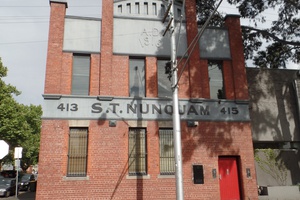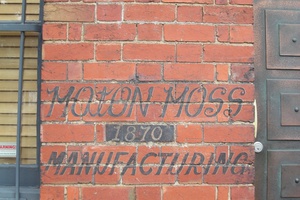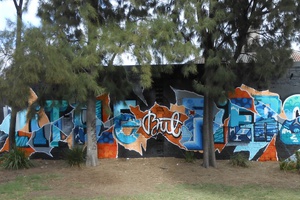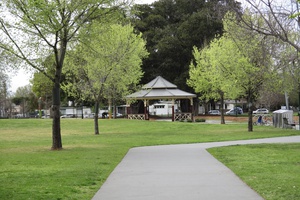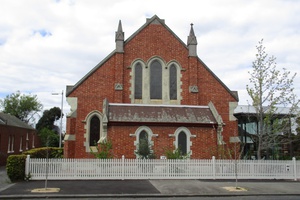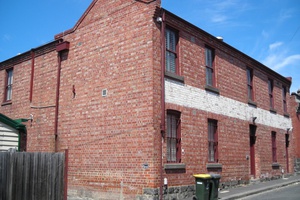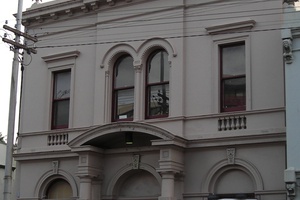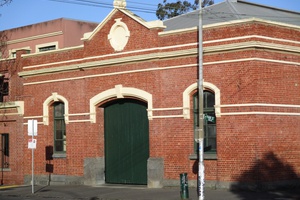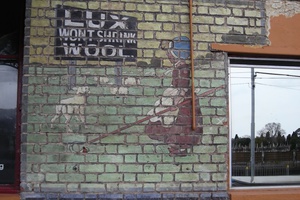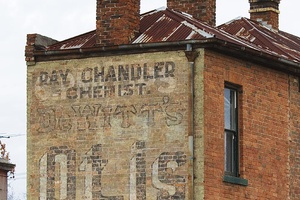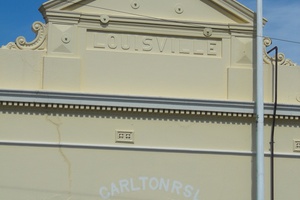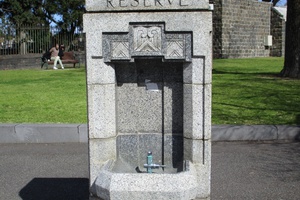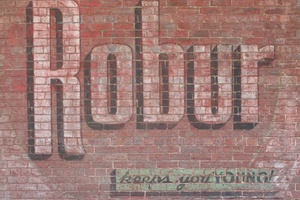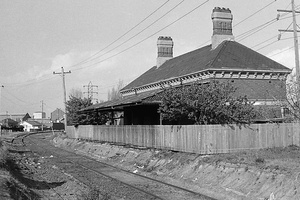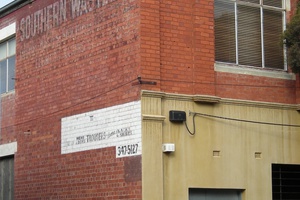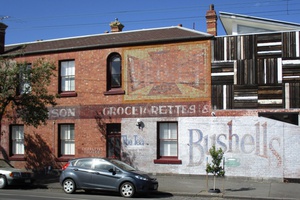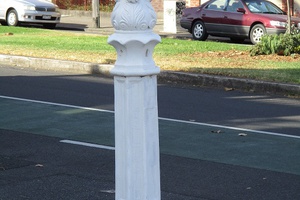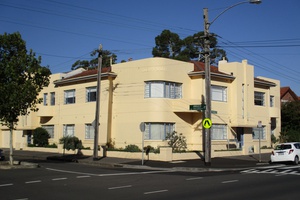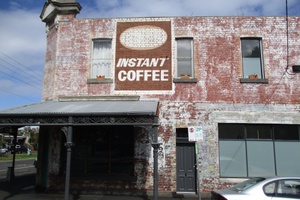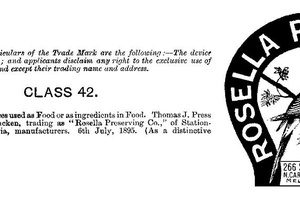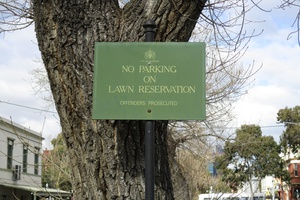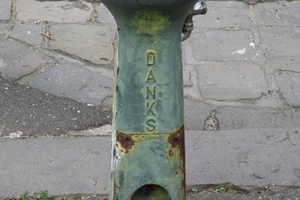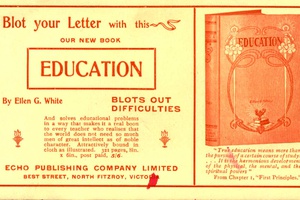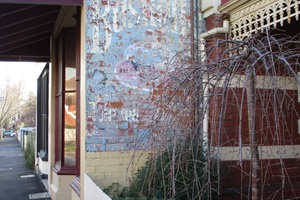This item is a part of these Themes
Monuments, Art & Signage
Jump To ThemeThere are other records in this place with a similar theme. Explore this theme by jumping to it from here. You can jump back to this piece later.
Other content from this author
-
Former factory of S.T. Nunquam, confectionery manufacturer.
The two-storey, red brick building on the corner of Newry Street was built by T.E. Mathews for Stanislav Techitch Nunquam, manufacturing confectioner, in 1916. Nunquam's factory was not the first manufacturing facility to operate at the corner site. Russell & Sons, manufacturing confectioners, were there from 1909, and Johnston Brothers, furniture manufacturers, prior to that date. There were two cottages (nos. 417 and 419) on the northern boundary and these were later separately acquired for expansion of the business. In 1920, a boiler and chimney stack were built in the backyard of the cottage at 417 Nicholson Street. In 1955, ownership of the factory building and adjacent cottage (no. 417) was transferred from S.T. Nunquam Pty Ltd to Nunquam Pty Ltd. The confectionery business that bore Nunquam's name continued for another three decades. The second cottage (no. 419) was acquired in 1978. The factory ceased manufacturing in the late 1990s and the cottages were demolished in 2000 and replaced with modern structures. The converted factory building is now residential apartments. Mr Nunquam’s original name was Stanislav Techitch. The surname “Nunquam” – the Latin word meaning “never” – was adopted in later life.
cchg
-
The Cotton Mill, 60 Curtain Street, North Carlton
The two-storey brick building opposite Curtain Square bears the name "Moton Moss Manufacturing" and the date of 1870. Moton Moss was the original crown land owner, in 1870, of the allotment on the corner of Canning and Freeman (later Curtain) Streets, North Carlton. Moss was a merchant by trade and he had extensive land holdings in Carlton and elsewhere in Victoria. He sold the corner allotment within six months of purchase and he died in 1879, fourteen years before the factory was built. In 1893, the factory and adjoining house at 333 Canning Street were built by Ralph Besant for Charles Edgley, a shoe manufacturer. Edgley lived in the corner house and conducted his shoe business at the factory. Other businesses followed – upholsterer, cabinetmaker, tie & scarf manufacturer and bootmaker. Elite Pleaters, a pleated skirt manufacturer, was the longest running occupant of the building from the 1930s through to the 1970s. The most famous owner/occupier of the converted factory was Greg Ham (1953-2012), musician and member of the pop group Men at Work. The building is named "The Cotton Mill", but the popular notion that it was originally a cotton mill, built in the 1870s, is not supported by evidence.
cchg
-
Shakespeare Street, North Carlton
The mural facing the mini park was painted in 2018. The text "Little but Fierce" is taken from William Shakespeare's play "A Midsummer Night's Dream" and was suggested by a local resident. The full wording is: "And though she be but little, she is fierce". Shakespeare Street has an interesting history. The houses were built in the 1870s and 1880s and the scout hall on the north side was added in 1929. The street was identified as a "slum pocket" by the Housing Investigation and Slum Abolition Board in 1936-37. In the 1950s and 1960s, the Housing Commission of Victoria condemned five cottages on the south side (nos. 7 to 15 inclusive) as unfit for human habitation. The cottages were demolished in January 1970, leaving a vacant space ready for development. Residents and concerned citizens took action, at their own expense, against plans for the inappropriate building of a block of cluster flats. They entered into an agreement with the City of Melbourne to buy the land and created a mini park for the benefit and enjoyment of the community. More information: http://www.cchg.asn.au/small.html# shakespeare
cchg
-
Curtain Square, North Carlton
Curtain Square, also known as Curtain’s Square, was named in honour of John Curtain, a Melbourne City Councillor and Member of Parliament who was instrumental in having the land reserved for ornamental and recreational purposes in May 1876. The square occupies 1.46 hectares of the area bounded by Rathdowne, Curtain, Canning and Newry Streets. The land was originally a bluestone quarry worked by convicts from the Collingwood Stockade from 1853 to 1866. The old quarry holes were filled in and the area was planted with a variety of trees and shrubs. The legacy of this infill material was noted years later in the Curtain Square Masterplan of 1992. Cracks in the walls of buildings, constructed in the 1930s and 1940s, were attributed to subsidence on the former quarry site, as was the tilt of the elm trees in the vicinity. The buildings, a "men's shelter" and a toilet block, were demolished in the 1990s. In September 2017 sixteen elm trees, some estimated at 100 years old, were removed from the north/south avenue and replaced with scarlet oaks, due to their poor condition and public safety concerns. The avenue of Moreton Bay fig trees remains at the Canning Street entrance.
cchg
-
Shakespeare Street, North Carlton
The mural facing the mini park was painted in 2018. The text "Little but Fierce" is taken from William Shakespeare's play "A Midsummer Night's Dream" and was suggested by a local resident. The full wording is: "And though she be but little, she is fierce". Shakespeare Street has an interesting history. The houses were built in the 1870s and 1880s and the scout hall on the north side was added in 1929. The street was identified as a "slum pocket" by the Housing Investigation and Slum Abolition Board in 1936-37. In the 1950s and 1960s, the Housing Commission of Victoria condemned five cottages on the south side (nos. 7 to 15 inclusive) as unfit for human habitation. The cottages were demolished in January 1970, leaving a vacant space ready for development. Residents and concerned citizens took action, at their own expense, against plans for the inappropriate building of a block of cluster flats. They entered into an agreement with the City of Melbourne to buy the land and created a mini park for the benefit and enjoyment of the community. More information: http://www.cchg.asn.au/small.html#Shakespeare
cchg
-
Princes Hill Primary School 2955, Pigdon Street, Princes Hill
The school opened in a two storey building in Arnold Street, Princes Hill in 1889. In 1908 it became a practising school for trainee teachers from Melbourne Teachers’ College. This meant many innovations were introduced or trialled at the school. In 1911 the Education Department bought a former bootmaker’s factory in a lane behind Arnold Street. Woodwork classes for boys (called Sloyd, from a Swedish method of instruction) were held downstairs, and cookery for girls upstairs. In 1899 infant teaching was established with the classroom and activities modified for small children. The school had the first Mothers’ Club in Victoria, which began in 1917 as the Princes Hill Mothers’ Story-Telling Club. In 1916 a first form class was introduced with a modified High School curriculum. In 1924 the infant classes relocated to the ‘little’ school in a new building in Pigdon Street. During World War 2 junior forms from University High School were relocated to Princes Hill and in 1944 Princes Hill became a Central School. In 1959 the primary classes moved to Pigdon Street and the Arnold Street building became Princes Hill High School.
cchg
-
Carlton North Primary School 1252, Lee Street, North Carlton
The school was originally known as the Stockade School and was built on the site of a former prison stockade and lunatic asylum. The Collingwood Stockade operated there from 1853 to 1866, and the lunatic asylum from 1866 to 1873. The school opened for enrolments in July 1873 and reached over 400 pupils within weeks. Classes were initially held in the former asylum buildings, but the facilities were inadequate and a new school was built during 1877 and opened in June 1878. This building is now the main administration building, facing Lee Street. The former prison superintendent’s residence, a bluestone cottage near the corner of Canning and Lee Streets, was demolished in 1913 to make way for the new infant school, opened in 1915. During demolition, workmen discovered several underground cells, which were thought to date back to the stockade era. The weatherboard caretaker’s cottage, on the corner of Canning and O’Grady Streets, was demolished in the 1980s, opening up space in the school grounds. The school’s historic buildings have undergone many changes over the years, in keeping with the demands of modern education, but have retained much of their original character.
cchg
-
St Michael’s Anglican Church, Corner of McIlwraith and Macpherson Streets, Princes Hill
Prior to 1885, there was no Anglican church in North Carlton and Princes Hill to serve the pastoral needs of the growing population. The nearest churches were St Jude's in Lygon Street, Carlton, and St Luke's in St George's Road, North Fitzroy. In 1885, Bishop Moorhouse sanctioned the separation of North Carlton to form a separate parish and St Michael's was born. A suitable site was found on the corner of Tucker (now McIlwraith) and Macpherson Streets and the land was procured by James Moorhouse, William Edward Hearn and Thomas Turner a'Beckett on behalf of the Anglican Church. The foundation stone for the church was laid by Sir George Verdon on 18 February 1885 and the opening service was held on Sunday 24 May in the same year. The brick church was designed by architect James Gall (Gaul) and built by Robertson & Stewart. The new parish and the building of the church had the full support of the community. The architect drew up the plans free of charge and the project was funded by donations and interest-free loans. Parishioners provided material support with donations of carpeting, chairs and other furniture, a church bell, collecting plates and communion cloths.
cchg
-
Former Laboratory Building, Herbert Street, North Carlton
The two-storey laboratory was designed by architect A.H. Cutler and built by John Hill for Arthur C. Parkin, a manufacturing chemist, in 1886. The first floor was extensively damaged by fire in July 1899, when a silk sieve ignited and the flames spread rapidly. In November 1903, Mr Parkin was fined for selling adulterated raspberry vinegar. Government analysis confirmed the product contained mostly water, sulphuric acid (added as preservative) and colouring matter, with "very little, if any" raspberry juice. Arthur Parkin & Company expanded the business in 1910-11, building a single storey warehouse on the north side of Herbert Street. Mr Parkin died in 1939, but his company continued to operate from the premises in Herbert Street until the 1950s. The former laboratory building was home to F. Agostino & Co, wine and spirit merchants, for ten years from 1956, followed by Dorado Distributors from 1966. A photo taken in 1984 for the Carlton, North Carlton and Princes Hill Conservation Study shows the wording "Dorado Distributors" on the front of the building, now faded to outline. The 1980s and 1990s saw major changes, with conversion of both the laboratory building and warehouse for residential use.
cchg
-
Carlton Hall (Dancehouse), 150 Princes Street, North Carlton
Carlton Hall was built by John Pigdon in February 1877, in controversial circumstances during the election campaign for the new seat of Carlton. James Munro, a temperance advocate, stood against Carlton publican John Curtain. Munro's opponents allegedly prevented him from hiring a hall in Carlton, so he countered their opposition by building his own hall, at a claimed cost of £2,000. James Munro won the seat of Carlton by a narrow majority in May 1877 and he honoured a pre-election promise in granting 2 years' free rent to the Carlton Mechanics' Institute. Carlton Hall provided temporary premises for the Carlton court of petty sessions and was home to several temperance organisations, friendly societies and masonic lodges. It served as a polling booth for state and municipal elections and was the focus of victory celebrations following the end of World War 2 in August 1945. From 1947 until the late 1960s, the Carlton sub-branch of the RSL was based at Carlton Hall. The Carlton Community Centre was located there in the 1970s and offered community activities, school holiday programs and classes to residents of Carlton and North Carlton. The contemporary dance hub Dancehouse has been in residence since June 1992.
cchg
-
Kent Hotel, 370 Rathdowne Street, North Carlton
The Kent Hotel is one of three remaining Victorian-era hotels in North Carlton. The Kent was first licensed to Charles Smart, a builder, in June 1873 and it was a popular place for meetings and community activities. The familiar art deco façade was added in the 20th century, but the hotel went through a rough patch in the 1950s and 1960s. Local businesses and residents bore the brunt of the unruly behaviour of drunken patrons leaving the hotel. The Kent was shaken to its foundations in September 1973, when a military hand grenade was thrown at the south wall along Curtain Street. The hotel wall and parked cars were damaged and two hotel patrons, who happened to be standing outside, were injured by shrapnel. Forensic examination of the crime scene revealed that, had the grenade been fully primed, there would have been surface damage within a 600 metre radius and fatalities within a 30 metre radius. With the advent of gentrification, the Kent has left its shady past behind and now attracts a different class of patron. The glass-panelled, bifold doors, installed in the early 21st century, have opened up the hotel floor space for al fresco drinking and dining.
cchg
-
Tram Sheds and Cable Winding House, Rathdowne Street, North Carlton
From 9 February 1889 to 2 August 1936, Rathdowne Street had a cable tram service running between Elgin and Park Streets. The engine house containing the steam-driven cable winding mechanism was built on the corner of Rathdowne and Park Streets. The building was designed by Melbourne Tramways Trust architect Robert Gordon and constructed of brick on a bluestone base. The adjacent tram shed was designed by architect Frederick Williams and built by Robert Fraser of Parkville. Cable trams had their heyday in the 19th century, but lasted only a few decades into the 20th century. The cable winding mechanism was converted from steam to electric power in 1919, but the cable trams’ days were numbered. The last tram service along Rathdowne Street was on the evening of 2 August 1936, and motor buses commenced along the same route the next day. The tracks and cables were dug up and the full width of the road was given up to vehicle traffic. The median strip was created and planted with trees in the late 1970s, in order to slow down traffic. The old cable tram buildings had a variety of industrial uses and, more recently, have been converted to residential apartments.
cchg
-
Oratava, Oruba and Ormuz, 299-303 Pigdon Street, Princes Hill
Oratava, Oruba and Ormuz are three handsome double fronted houses in Pigdon Street, Princes Hill. The houses were built by Joseph Hince between 1899 and 1900 and they are named after ships that brought immigrants to Australia in the late nineteenth century. Ormuz was built for the Orient line as a passenger ship and began voyages to Australia in 1877. The ships carried three classes of passengers. The Oratava and Oruba were built for the Pacific Steamship Company and initially sailed to Valparaiso. They commenced voyages to Australia in mid 1890. The Oratava was a troopship during the Boer War and in 1906 both the Oruba and the Oratava became Royal Mail vessels to the West Indies. Orotava became a merchant cruiser in World War 1.
cchg
-
Drinking fountain, near Cemetery north gate, Macpherson Street, Princes Hill
The fountain with the bust above is a memorial to William Cook, who served as a Melbourne City Councillor for Victoria Ward from 1894 to 1909. He lived in the house called “Hassall Green” at 797 Drummond Street, on the corner of Macpherson Street, North Carlton. Every year he gave a Christmas party for local residents, and provided presents for all those who attended. When he died in August 1909, his funeral procession of horse drawn carriages and people on foot stretched from his home to the Melbourne General Cemetery gates in College Crescent. The memorial was built with funds raised by the people of North Carlton and Princes Hill.
cchg
-
Advertising signs, corner of Lygon and Fenwick Streets, North Carlton
Renovations to the former grocery shop in 2010 uncovered colourful advertising images that had been hidden under layers of render for many years. Lux Flakes and Velvet Soap have been on the Australian market for more than a century and are now both brands of Pental Products Pty Ltd. Lux was originally manufactured by Lever Brothers and Velvet Soap by J. Kitchen & Sons of Port Melboure. J. Kitchen & Sons also manufactured Electrine Candles, advertised as “the finest candle in the world”. Hardy's Jelly Crystals and Butterfly Dutch Cocoa were products of local merchant R.J. Hardy & Co. Butterfly Dutch cocoa, as its name suggests, was imported from Holland, and R.J. Hardy & Co. was the local agent. Robert John Hardy began his business in a cottage at 216 Macpherson Street, Princes Hill, opposite the Melbourne General Cemetery. Hardy later moved to "Wahroonga", 870 Lygon street, North Carlton, while retaining the cottage and warehouse for business purposes. He died at "Wahroonga” in May 1937. Robert Hardy was a Melbourne City Councillor from 1915 to 1937 and the reserve on the northern boundary of the cemetery was later named Hardy Reserve, in memory of Councillor Hardy and his son Fred.
cchg
-
Advertising sign, rear of 536 Rathdowne Street, North Carlton
Otis tonic tablets, manufactured by E.C. De Witt & Company, were advertised as a "guaranteed remedy for debility, brain fog, anaemia, depression, morbidness, maternity weakness, neurasthenia, insomnia, premature decay and all ailments arising from blood poverty or depleted nervous energy." De Witt was so confident of the product that it offered a full refund if the tablets "fail to do all that is claimed of them". Advertisements for Otis tonic tablets appeared in newspapers from 1922 to 1925 - a relatively short life - while other De Witt's products continued well into the 20th century and beyond. Were Otis tonic tablets a victim of their own money back guarantee? 536 Rathdowne Street has a long history of continuous service as a chemist shop from 1913 to 1987. The first chemist, O. Smith, opened for business in 1913, followed by C. Phillips from 1921 to 1925. The wording "C. Phillips" is just visible under Ray Chandler's name. Chandler served the local community until 1947, continued by I.L. Atkins from 1948 to 1967, and S. Benporath from 1968 to 1978. David Nolte was the final chemist shop occupant from 1979 to 1987, when he moved to new premises at 701 Rathdowne Street.
cchg
-
Louisville, 60 Amess Street, North Carlton
In 1890 Louis Soumprou built Louisville, as he modestly named it, a hall on the corner of Amess and Mapherson Streets, North Carlton and opened his dancing academy. A successful teacher, he taught in other locations as well. Advertisements cited his ability to teach "the tango, maxixe and all the latest dances." During the 1890s annual balls were held at Louisville with up to 100 people attending. By 1907 this popular event had moved to a larger venue. Remarkably, Louis’ school continued to 1931 when very reasonably (the man was then 67) he hung up his dancing shoes. Louisville was then put to a very different use. At that time there was a very substantial Jewish population in North Carlton and the Hascola Talmud Torah moved in with up to 200 children a day attending after-school Hebrew classes. By the late 1930s the sale of the building forced the school to move and the hall was then owned for many decades by the Returned Sailors’ Soldiers’ & Airmen’s Imperial League of Australia (later the RSL). At different times tenants included a local branch of the R.O.A.B. and, in the 1950s, Avonleigh House Receptions. Today Louisville is a private dwelling.
cchg
-
Hardy Reserve, Macpherson Street, North Carlton
Hardy Reserve is named after two members of the same family, father and son Robert and Fred Hardy, both of whom served on the Melbourne City Council. Robert John Hardy, a local resident and merchant, was elected to Victoria Ward on 17 May 1915 and represented his constituents until his death at the age of 67 years on 23 May 1937. He was buried at the new Melbourne General Cemetery at Fawkner, where he was on the board of management. Two years later, his son Frederick George Jack (Fred) Hardy was elected to Victoria Ward on 24 August 1939. Fred Hardy served in this capacity until his death on 29 May 1975, at the age of 68 years. Like father, like son.
cchg
-
Advertising sign for Robur Tea, Macpherson Street, North Carlton
According to this advertisement, Robur tea “peps you UP” and “keeps you YOUNG!” The caffeine content of tea, while not as high as coffee, could account for the “pep” factor and tea contains antioxidants, which are claimed to delay the ageing process. The brick wall that features the advertising signage faces what was originally the back yard of a grocer’s shop, on the corner of Canning and Macpherson Streets. The brick corner shop, together with a cellar and stables, was built for grocer Carlo Pescia in 1883. The adjoining house on the west side of the wall, now numbered 68 Macpherson Street, was built in 1887 and was subdivided from the shop and yard in 1924. The shop has had a variety of business uses during its history, including a dairy produce merchant, confectioner and fruiterer. It is now a naturopath’s practice and private residence.
cchg
-
Eolian Hall (Former Kadimah), 836 Lygon Street, North Carlton
The hall at 836 Lygon Street, North Carlton, was built in 1933 to house the Kadimah, a Jewish cultural organization founded in Melbourne in 1911 to meet the needs of newly-arrived Yiddish-speaking Jews from Eastern Europe. The new building, well-sited in an area where there was already a substantial Jewish population, included a 400-seat capacity theatre/hall and library. Its numerous activities included lectures, concerts, plays and social events of all kinds. After World War 2 a stream of new arrivals made the Kadimah even more influential as a focal point of Jewish cultural life. By 1950, it had a thousand members and a paid librarian was required to cope with the growing demand for books and newspapers. However, as these hardworking newcomers prospered, there began a steady drift of Carlton Jews to suburbs south of the Yarra river and by 1969 the Kadimah had to follow. The houses vacated by the Jewish migrants were soon occupied by a wave of Italian arrivals. It is fitting therefore that the Kadimah became the new home of an Italian cultural organization, Società Isole Eolie, founded in 1925 and still flourishing in 2018, its activities still focused on this landmark Carlton building.
cchg
-
Former Tel Aviv Dairy, 183 Macpherson Street, North Carlton
In the days before milk was sold in bottles or cartons, dairies were common. Often they were very small operations selling milk from a gate into the backyard of a house. Somewhat larger was the dairy at 183 Macpherson Street, North Carlton where a yard with outbuildings sat beside a double-fronted Victorian house. In 1926 it was taken over by the Pahoff family who had earlier fled anti-semitism in their native Ukraine. Like many in the substantial Jewish population of Carlton at that time, they were Yiddish-speaking. The business flourished and from 1937 became known as the Tel Aviv dairy. Once established in Carlton, Myer and Chaya Pahoff began to assist the emigration of relatives in Ukraine by lending them money for fares. They met every boat on which relatives arrived and had accommodation waiting for them. The newcomers then had to repay the debt to finance further sponsorships. By 1929, when the Soviet government stopped migration, the Pahoffs had thus assisted more than 40 related families. The dairy ceased trading in 1967 but family members continued to live in the house until 2013, when the side yard where carts and horses were once housed was still quite unchanged.
cchg
-
Railway House, 20 Solly Avenue, Princes Hill
Built in 1888 as the North Carlton railway station on the now defunct Inner Circle Line, this building is now a neighbourhood house. The Inner Circle Line operated as a suburban passenger line from 1888 until 1948, and beyond that as a freight line. It ran from Royal Park station on the Upfield Line, due east across the northern end of North Carlton and North Fitzroy to Rushall station on the Epping Line. After the passenger line closed in 1948, the station was converted to a house for a railway worker and his family, and later became vacant and derelict. In the early 1970s, plans to use the railway land on which it sat for warehouses and other industrial purposes were thwarted by local residents who, supported by trade unions, ran a successful campaign to have it converted into a park for community use. With the conversion to park land underway, local community groups began working to have the old railway building turned into a community centre. Today the building has been fully renovated and now functions as the North Carlton Railway Neighbourhood House, hosting a diverse range of activities from cooking to choirs to children's parties.
cchg
-
Advertising Sign, 9 Fenwick Street, North Carlton
The Southern Waste Company, cotton waste manufacturers, occupied this building in the 1940s. It was originally built for Henry Gotardo Foletta by A. Moyle in 1912. The telephone number 347-5127 is for a more recent business occupant, Longwear Products. The building is now a private residence.
cchg
-
Advertising Signs Park Street, North Carlton (Corner Canning Street)
The brand names Velvet and Bushells feature in signage on the side wall of a former shop at 683 Canning Street, North Carlton. The building is now a private residence.
cchg
-
Gas Lighting in Carlton and North Carlton
In the days before the advent of electricity, the streets of Carlton were illuminated with gas lighting. There were gas lamps on many street corners and several examples still remain, as truncated lamp post bases. The Melbourne and Metropolitan Board of Works (MMBW) detail plans, drawn up in the late 19th and early 20th century, include codes showing the location of gas lamps (G.L.) and electric light posts (E.L.P.). The two methods of illumination co-existed for a time, but electric lighting eventually took over and the gas lamps were decommissioned. The upper portions of the lamp posts were removed, leaving the decorative bases.There are gas lamp bases at the following locations: Corner of Amess and Pigdon Streets, North Carlton ; Corner of Canning and Fenwick Streets, North Carlton ; Corner of Canning and O'Grady Streets, North Carlton ; Corner of Nicholson and Pigdon Streets, North Carlton (removed in October 2019) ; Corner of Amess and Richardson Streets, North Carlton ; Corner of Lygon Street and Argyle Place, Carlton ; Corner of Swanston and Pelham Streets, Carlton ; Corner of Rathdowne and Barkly Streets Carlton.
cchg
-
Rosh Pinah, 311 Pigdon Street, Princes Hill
Rosh Pinah, the corner block of flats at 311 Pigdon Street, Princes Hill, was designed by Archibald Ikin and built in 1940 for Norman and Rosa Shnider. The name "Rosh Pinah", which means "cornerstone" in the Hebrew language, is taken from Norman Shnider's birthplace of Rosh Pinah in Palestine. Norman was born there on 22 August 1903 and he migrated to Australia as a child in August 1914. The block of flats has a heritage listing and is described in the City of Yarra Review of Heritage Precincts (2007) as: "The Rosh Pinah flat block is significant as a large two-storey stuccoed building set on a corner site, with parapeted and hipped terra-cotta clad roofs, steel framed windows, bold curved architectural forms, original fence – all designed in the Moderne style. Rosh Pinah also represents the Jewish presence in North Carlton and adjacent areas, as an early phase of modern European emigration into Melbourne in the 1930s.” Rosh Pinah features as a location in Robert Gott's crime novel The Port Fairy Murders, published by Scribe in 2015.
cchg
-
Former Shop, Corner of Canning and Pigdon Streets, North Carlton
You won't find instant coffee on the menu at Café BÜ, at the rear of 585 Canning Street, North Carlton. The prominent signage on the brickwork facing Pigdon Street harks back to an earlier time, when the convenience of instant coffee was valued over flavour.Until 1889, the corner site was vacant land owned by Thomas Allison. In July of that year, Mr Allison lodged a notice of intent to build "six 2-storey houses" on the corner of Canning and Pigdon streets. The buildings were designed by James Clarke and built by Donald McDonald. Construction work was still in progress in 1890, when the rate books listed three houses and a shop as "erecting" in Canning Street (nos. 579 to 585), and two houses around the corner in Pigdon Street (then nos. 87 and 89, now nos. 75 and 77). The shop began its life as a greengrocer in 1891, followed by a grocer and confectioner. In the second half of the 20th century, it was a milk bar. The milk signage is clearly visible at the front door and remnants of Bushells and Lanchoo tea signage can be seen in Pigdon Street and on the upstairs rear wall.
cchg
-
The Rosella Preserving Company in North Carlton
The iconic Australian brand name Rosella is traditionally associated with the Melbourne suburb of Richmond, where the company's jams, sauces and preserves were manufactured until the 1980s. It may come as a surprise that Rosella had its origins in North Carlton, a decade before the Richmond factory was established in 1905. Rosella's founders Horatio McCracken, a commission agent, and Thomas Press, a grocer, began making jam as a backyard business in the 1890s. In July 1895, they registered the Rosella Preserving Company trade mark. The address of 266 Station Street, North Carlton, was originally a brick blacking factory built by James Dunster in 1880 or 1881. The factory was owned by the Royal Insurance Company from 1893 to 1898. In November 1895, the Rosella Preserving Company Limited was registered, with an office address of 134 and 136 Flinders Street, Melbourne. According to rate book records, McCracken and Press occupied the North Carlton factory site in 1896. In November 1897, the Rosella Preserving Company moved to Errol Street, North Melbourne, then to purpose-built premises in Balmain Street Richmond in 1905. The Station Street factory was demolished and replaced by two cottages (nos. 266 and 268) in 1899.
cchg
-
Relics of Melbourne City Council in North Carlton
The NO PARKING sign, bearing the Melbourne City Council's name and coat of arms, is a relic of times past, when Carlton, North Carlton and Princes Hill were all part of the same municipality. North Carlton and Princes Hill were hived off from Melbourne City Council and joined the newly-created City of Yarra in the 1990s. There are plenty of other reminders of Melbourne City Council to be found in North Carlton and Princes Hill. The coat of arms appears on street bollards and in the iron lacework of many shopfront verandahs. The images of fleece, bull, whale and sailing ship date back to 1843, when wool, tallow and oil were the chief exports of the colony (then part of New South Wales). The whale and sailing ship images have since been relocated to the lower half of the coat of arms, while the bull has been moved up to join the fleece on the upper half. The change was made in 1970 in order to have the land-based and water-based images placed, logically, on their respective levels. More Information: https://www.melbourne.vic.gov.au/about-melbourne/melbourne-heritage/history/pages/coat-of-arms.aspx
cchg
-
DANKS DRINKING FOUNTAIN
This drinking fountain, manufactured by Danks of South Melbourne, was decommissioned several years ago. Walkers now have to go to Princes Park or Curtain Square to slake their thirst.
cchg
-
Echo Publishing Company Limited
This postcard-sized advertisement for Echo Publishing Company Limited of North Fitzroy was discovered amongst some notebooks, handwritten by William Wilson of Drummond Street, Carlton. Mr Wilson was a student at the Education Department Training College in Grattan Street, Carlton, in the early 1900s. The advertisement served a dual purpose in promoting a book by American author Ellen G. White, and the verso could also be used as a blotter – a smart way of advertising in the days of pen and ink. The Echo Publishing Company Limited began as a small-scale religious publisher and printer on the corner of Rae and Scotchmer Streets, North Fitzroy, in 1886. The business expanded its operations to include commercial work, and moved to larger premises at 14-16 Best Street, North Fitzroy in 1889. The Company, run by the Seventh Day Adventists, reviewed its operations in the early 1900s and made the decision, based on its religious principles, to discontinue commercial work and leave the city for Warburton. The North Fitzroy factory was vacated in February 1907. William Wilson's notebooks were kindly donated to CCHG by the Yarra Ranges Regional Museum. The advertising blotter is now in the local history collection of the Fitzroy Library.
cchg
-
Advertising Sign for Bushell's Tea in Rathdowne Street
This faded sign for Bushell's Tea appears on the south-facing wall of 602 Rathdowne Street and can be viewed from the house at 600 Rathdowne Street. The building at 602 Rathdowne Street, North Carlton was a grocery shop from the mid-1900s through to the mid-1960s.
cchg
